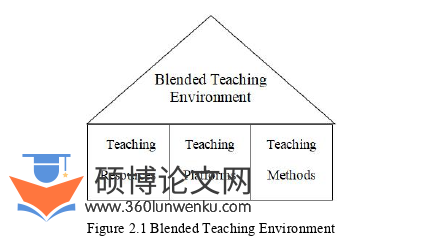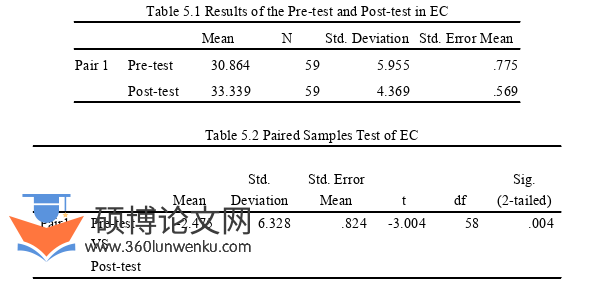本文是一篇英语论文,EC实施混合教学,CC实施语法翻译教学法。本研究将混合式教学分为三个阶段:课前、课中和课后。课前,学生在雨中课堂预习,培养学生的自学能力。学生了解文章的文化背景后,可以更好地理解文章的内容。在课堂上,老师讲解并训练学生的阅读技能。课后,教师对学生进行测试,以便教师及时了解学生对知识的掌握情况,及时调整教学方法。
Chapter 1 Introduction
1.1 Research Background
1.1.1 Information Technology of Promoting the Reform of College EnglishTeaching
With the rapid development of educational informatization, informationtechnology is changing students’ learning styles at an amazing speed. People begin tothink about how to use information technology to carry out classroom teaching reform.Internet technology under the background of information technology has graduallypenetrated all fields of education. From teaching to management, all reflect theimportant role of information technology. While promoting the development andreform of education, technology not only updates teachers’ educational ideas,educational methods, and teaching contents but also makes significant changes instudents’ learning and thinking styles. Compared with traditional education andteaching, the integration of information technology and subject curriculum hasachieved the purpose of applying technology to the classroom to improve classroomefficiency, reform the teaching mode, and promote educational development. It can beseen that information technology is of great significance to the reform of educationand teaching. As the product of the integration of information technology andtraditional classroom, the rise and development of blended teaching takes theinformation age as the background, integrates the advantages of the online classroomand traditional classroom, and maximizes the function of teaching. The application ofblended teaching to classroom teaching meets the requirements of urgent reform ofsubject classrooms under the rapid development of informatization and meets the callfor innovative development of subject teaching under the background ofinformatization.
...............................
1.2 Research Purposes
In traditional English teaching, teachers adopt the grammar-translation teachingmethod. The characteristic of this teaching method is that teachers pay too muchattention to the explanation of language knowledge points in class, students’enthusiasm for learning is not high, and teachers ignore students’ interest in learning.The decline of students’ interest in learning will affect the improvement of learning scores. College English Curriculum Requirements puts forward that teachers shouldseek a new teaching mode, use information technology in teaching, and providestudents with a flexible learning environment. Hence, it is necessary to apply blendedteaching to the teaching of college English reading.

英语论文怎么写
The main purposes of this study include the following two points. The thesis toverify that: (1) blended teaching can improve college students’ scores in Englishreading, and (2) blended teaching can enhance college students’ interest in Englishreading.
................................
Chapter 2 Literature Review
2.1 Definition of Blended Teaching
2.1.1 Definition of Blended Teaching Abroad
Blended teaching systems combine face-to-face instruction withcomputer-mediated instruction (Graham, 2006). Blended teaching is a blend of onlineand face-to-face instruction (Reay, 2001). It is a combination of face-to-face (F2F)and computer-assisted learning (CAL) in a single teaching and learning environment(Neumeier, 2005). According to Rooney (2003), blended teaching has been identifiedby the American Society for Training and Development (ASTD) as one of the top tentrends to emerge in the knowledge delivery industry. The term blended teachingreferred to a language course that combines the use of technology and pedagogicalapproaches (Driscoll, 2002). Blended teaching is an instructional approach thatsubstitutes online learning for a portion of the traditional face-to-face instructionaltime(Owston, 2013).
2.1.2 Definition of Blended Teaching at Home
Blended teaching combines the advantages of E-learning, which fully reflects theinitiative, enthusiasm and creativity of students as the main body of the learningprocess (He Kekang, 2004). The basic form of blended teaching is the organiccombination of face-to-face teaching between teachers and students and students’online learning ( Li Kedong, Zhao Jianhua, 2004). Yang Fang, Wei Xing and ZhangWenxia (2017) pointed out that blended teaching is not to replace thegrammar-translation teaching method but to integrate the teaching activities of onlinelearning and offline learning through teaching design, to maximize the benefits ofteaching. Mou Zhansheng, Dong Bojie (2004) stated that blended teaching is amixture of autonomous learning, collaborative learning, receptive learning, and discovery learning, it is a mixture of different learning environments and differentcommunication methods between teachers and students online and offline. Blendedteaching is a teaching mode with complementary advantages of thegrammar-translation teaching method and network teaching (Zhang Qiliang, WangAichun, 2014). Blended teaching focuses on the application of “appropriate” teachingtechniques to match “appropriate” personal learning styles, so as to transfer“appropriate” skills to “appropriate” people at “appropriate” time (Zhu Zhiting, MengQi, 2003).
................................
2.2 Previous Studies on Blended Teaching in English Teaching
2.2.1 Blended Teaching in English Teaching Abroad
Foreign scholars have done some research on blended teaching. Blendedteaching has been the focus of many research studies. Several research results of usingthis teaching mode have been identified.
After examining the literature on blended teaching in English teaching, it wasfound that this teaching mode can be used to cultivate students’ English languageskills ( Behjat, Yamini, Bagheri, 2012; Adas, Bakir, 2013; Ghazizadeh, Fatemipour,2017; Aji, 2017; Astarilla, Warman, 2017; Syaifudin, 2017; Wahyuni, 2018;Syamsuddin, Jimi, 2019; Sujannah, Cahyono, Astuti, 2020; Isda, Purwati, Imran,2021), improve the learning environment ( Manan, 2012; Onah, Pang, Sinclair , 2020;Hadiyanto, Failasofah, Armiwati, etc., 2021), and develop students’ participation inEnglish learning ( Kaur, 2013; Banditvilai, 2016; Oweis, 2018 ).
A. Cultivating Language Skills
Several studies (Behjat, Yamini, Bagheri, 2012; Adas, Bakir, 2013; Ghazizadeh,Fatemipour, 2017; Aji, 2017; Astarilla, Warman, 2017; Syaifudin, 2017; Wahyuni, 2018;Syamsuddin, Jimi, 2019; Sujannah, Cahyono, Astuti, 2020; Isda, Purwati, Imran,2021) have indicated that teachers’ use of blended teaching can cultivate students’language skills. For example, when teachers use blended teaching to teach students,students’ abilities in speaking, listening, reading, writing, and vocabulary learning canbe further developed.
(1) In the aspect of reading. Ghazizadeh, Fatemipour (2017) stated that usingblended teaching in English classroom can promote students’ learning process,especially the learning of reading skills. Behjat, Yamini, Bagheri (2012) pointed outthat blended teaching encourages students to read more materials, and demonstratedthat utilizing blended learning programs could significantly better the reading skills ofundergraduate students. Blended teaching through WhatsApp had contributed to theachievement of undergraduate students’ reading comprehension (Astarilla, Warman,2017).
(2) In the aspect of speaking. Isda, Purwati, Imran (2021) aimed to investigatethe effect of blended teaching on enhancing students’ speaking skills, the result can beconcluded that blended teaching has a positive effect on students’ speaking skills. Theimplementation of blended teaching in Indonusa English Club to improve speakingskills, the result showed that speaking skills were improved ( Syaifudin, 2017).
..................................
Chapter 3 Theoretical Framework...............................15
3.1 The Origin and Development of Constructivism Learning Theory....................15
3.2 Definition of Constructivism Learning Theory...........................15
Chapter 4 Research Design.................................21
4.1 Research Questions.................................21
4.2 Research Subjects................................21
Chapter 5 Results and Discussion..........................32
5.1 Effect of Blended Teaching on College Students’ English Reading..................32
5.1.1 Pre-test and Post-test Scores of EC...................................32
5.1.2 Pre-test and Post-test Scores of CC.........................................33
Chapter 5 Results and Discussion
5.1 Effect of Blended Teaching on College Students’ English Reading
The thesis used SPSS to carry out independent sample t-test and paired samplet-test on the pre-test and post-test results of the two classes and analyzed anddiscussed the statistical results.
5.1.1 Pre-test and Post-test Scores of EC
The thesis makes statistics on the results of the pre-test and post-test in EC. SeeTable 5.1 and Table 5.2 for details.

英语论文参考
As is shown in Table 5.1, the average reading comprehension scores in thepre-test and post-test of EC are 30.864 and 33.339 respectively. The post-test mean is2.475 higher than the pre-test mean. It can be seen that after a semester of blendedteaching under the guidance of English reading teaching, students’ English readingperformance has been greatly improved.
.............................
Chapter 6 Conclusion
6.1 The Results of the Study
This study explored the influence of blended teaching on college students’English reading. Through the analysis of students’ reading scores before and after theexperiment and the analysis of interview results, the main findings are as follows.
6.1.1 Improving Students’ English Reading Scores
EC implemented blended teaching, CC implemented the grammar-translationteaching method. This study divides blended teaching into three stages: pre-class,in-class, and after-class. Pre-class, the students preview in Rain Classroom, whichcultivates the students’ self-study ability. After the students know the culturalbackground of article, they can have a better understanding of the content of article.In-class, teacher explains and trains students’ reading skills. After-class, teacher teststudents, so that teacher can timely understand students’ mastery of knowledge andmake timely adjustments to teaching methods.
Before the experiment, the average reading score of EC was 30.864, the averagereading score of CC was 30.833. There was no significant difference between the twoclasses. After the experiment, the average reading score of EC was 2.298 higher thanthat of CC. According to the independent sample t-test and paired sample t-test of ECand CC, the results show that the reading scores of EC students had significantlyimproved. Therefore, compared with traditional teaching, blended teaching canimprove college students’ English reading scores.
reference(omitted)
